Was Neues, Phantastisches aus der heimischen Hexenküche: ein Fw 190 D-9-Zwilling mit Booster-Strahltriebwerk in 1:72. Gab es so nie, aber ähnliche Dinge waren in Planung (wie die He 111, die Do 635 oder das Projekt Arado 530) bzw. einzelne Elemente wie die Triebwerkszelle, die z. B. als Zusatz für Me 410 oder He 219 angedacht war, um die Leistung zu steigern. Tja, und so was kommt dann raus...


1:72 Focke Wulf Fw 190 Z-17, aircraft „<1+–“, personal mount of Leutnant Werner von Giesen; Deutsche Luftwaffe, Stab of II./JG 53's; Kaufbeuren, early 1946 by
dizzyfugu, on Flickr
Some background:The Focke-Wulf Fw 190 Würger (English: Shrike) was a German single-seat, single-engine fighter aircraft designed by Kurt Tank in the late 1930s and widely used during World War II. The 190 was used by the Luftwaffe in a wide variety of roles, including day fighter, fighter-bomber, ground-attack aircraft and, to a lesser degree, even night fighter.

1:72 Focke Wulf Fw 190 Z-17, aircraft „<1+–“, personal mount of Leutnant Werner von Giesen; Deutsche Luftwaffe, Stab of II./JG 53's; Kaufbeuren, early 1946 by dizzyfugu, on Flickr

1:72 Focke Wulf Fw 190 Z-17, aircraft „<1+–“, personal mount of Leutnant Werner von Giesen; Deutsche Luftwaffe, Stab of II./JG 53's; Kaufbeuren, early 1946 by dizzyfugu, on Flickr
The Fw 190 became the backbone of the Jagdwaffe (Fighter Force), along with the Bf 109 which it never entirely replaced. On the Eastern Front, the Fw 190 was versatile enough to use in Schlachtgeschwader (Battle Wings or Strike Wings), specialized ground attack units which achieved much success against Soviet ground forces. As an interceptor, the Fw 190 underwent improvements to make it effective at high altitude, enabling it to maintain relative parity with its Allied opponents. The Fw 190A series' performance decreased at high altitudes (usually 6,000 m (20,000 ft) and above), which reduced its effectiveness as a high-altitude interceptor, but this problem was mostly rectified in later models, particularly in the Junkers Jumo 213 inline-engine Focke-Wulf Fw 190D series (nicknamed the Dora; or Long-Nose Dora, "Langnasen-Dora"), which was introduced in September 1944.

1:72 Focke Wulf Fw 190 Z-17, aircraft „<1+–“, personal mount of Leutnant Werner von Giesen; Deutsche Luftwaffe, Stab of II./JG 53's; Kaufbeuren, early 1946 by dizzyfugu, on Flickr
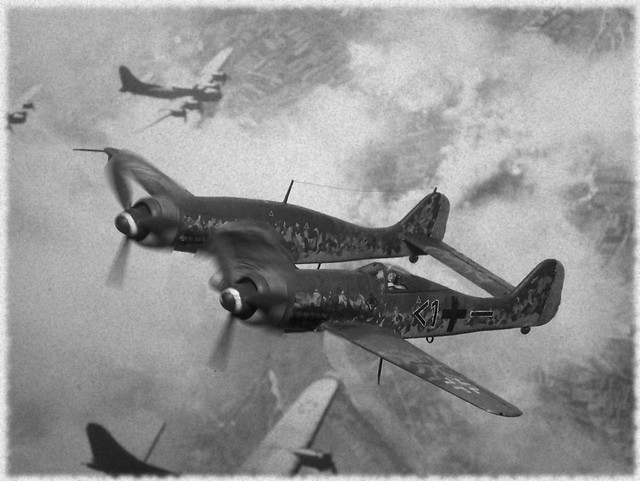
1:72 Focke Wulf Fw 190 Z-17, aircraft „<1+–“, personal mount of Leutnant Werner von Giesen; Deutsche Luftwaffe, Stab of II./JG 53's; Kaufbeuren, early 1946 by dizzyfugu, on Flickr
The Fw 190 D was intended to improve on the high-altitude performance of the A-series enough to make it useful against the American heavy bombers of the era. In the event, the D series was rarely used against the heavy-bomber raids, as the circumstances of the war in late 1944 meant that fighter-versus-fighter combat and ground attack missions took priority.
To make matters worse, the D was only seen as an interim solution, as Kurt Tank made it very clear that he intended the D-9 to be a stopgap until the Ta 152 arrived. These negative opinions existed for some time until positive pilot feedback began arriving at Focke-Wulf and the Luftwaffe command structure. Sporting good handling and performance characteristics, the D-9 made an effective medium altitude, high speed interceptor, although its performance still fell away at altitudes above about 20,000 ft (6,100 m). When flown by capable pilots, the Fw 190D proved the equal of Allied types.
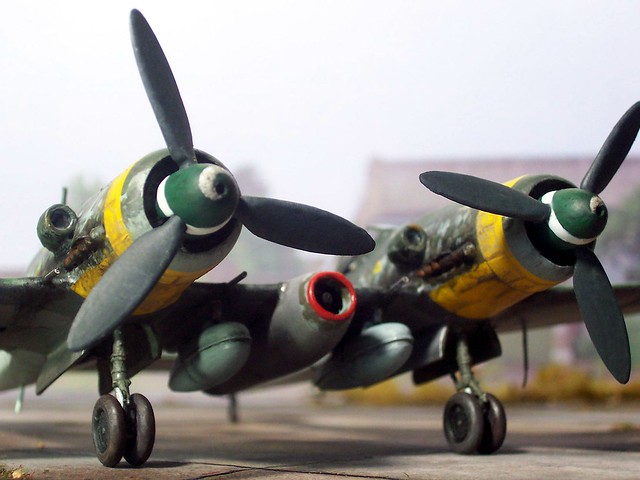
1:72 Focke Wulf Fw 190 Z-17, aircraft „<1+–“, personal mount of Leutnant Werner von Giesen; Deutsche Luftwaffe, Stab of II./JG 53's; Kaufbeuren, early 1946 by dizzyfugu, on Flickr

1:72 Focke Wulf Fw 190 Z-17, aircraft „<1+–“, personal mount of Leutnant Werner von Giesen; Deutsche Luftwaffe, Stab of II./JG 53's; Kaufbeuren, early 1946 by dizzyfugu, on Flickr
With the ever increasing threat of Allied bomber raids and the advent of the formidable Ta 152 fighter, several designs were tried in order to create a long range interceptor from the D-9. From the start it was clear that the increment in range would call for added fuel, which in turn would limit payload and performance to a level that rendered the idea pointless. Anyway, Georg Hager, a young engineer proposed a radical new idea, which was similar to the Twin Mustangs' idea which was under development at the same time in the USA for the Pacific theater: mating two Dora fuselages into a two-engined aircraft, which would meet the Luftwaffe's requirements and could mostly be built with the help of existing tools and jigs, getting it into service with almost no delay.

1:72 Focke Wulf Fw 190 Z-17, aircraft „<1+–“, personal mount of Leutnant Werner von Giesen; Deutsche Luftwaffe, Stab of II./JG 53's; Kaufbeuren, early 1946 by dizzyfugu, on Flickr

1:72 Focke Wulf Fw 190 Z-17, aircraft „<1+–“, personal mount of Leutnant Werner von Giesen; Deutsche Luftwaffe, Stab of II./JG 53's; Kaufbeuren, early 1946 by dizzyfugu, on Flickr
The result was the Fw 190 Z (for 'Zwilling' = Twin). The airframe was based on the single-engined D-13 fighter, only one cockpit was installed into the left fuselage, the respective space in the right fuselage was faired over and used for an internal tank.
The outer wings were directly taken from the Fw 190 D, even though the landing gear was totally redesigned: it retracted backwards into the lower fuselage and was fitted with twin wheels.
Both fuselages were connected by a new wing center section and a new tailplane, both of constant chord and simple construction. As Aluminum became scarce in the late years of WWII, some constructional changes had to be made, e. g. a rigid central wing spar made from steel. In other places, wood elements replaced Aluminum parts on the wings.

1:72 Focke Wulf Fw 190 Z-17, aircraft „<1+–“, personal mount of Leutnant Werner von Giesen; Deutsche Luftwaffe, Stab of II./JG 53's; Kaufbeuren, early 1946 by dizzyfugu, on Flickr

1:72 Focke Wulf Fw 190 Z-17, aircraft „<1+–“, personal mount of Leutnant Werner von Giesen; Deutsche Luftwaffe, Stab of II./JG 53's; Kaufbeuren, early 1946 by dizzyfugu, on Flickr
Two prototypes of the Z-16, how the type was officially called, were built in late 1944 and tested until March 1945. As the type proved to offer sufficient performance and no major handling problem was found, it was immediately put into production and service.
The Z-16 was fitted with all-weather flying equipment including the PKS12 and K-23 systems for steering and autopilot. The FuG 125 radio system, known as “Hermine”, was fitted to the aircraft, as well as a heated windscreen. The aircraft also featured a hydraulic boost system for the ailerons, which had been developed for the Ta 152. Armament consisted of six machine cannons, and this heavy armament allowed the Z-16 to deal quickly with enemy aircraft. Each fuselage carried three weapons: one 30 mm (1.18 in) MK 108 Motorkanone cannon centered within the propeller hub and two synchronized 20 mm MG 151/20 cannons located in the wing roots. Under the center wing, bombs of up to 1.000 kg caliber (2.202 lb) or drop tanks could be carried. Under the outer wings, wooden racks with 2× 12 unguided 'R4M' 55 mm (2.2 in) air-to-air rockets could be carried, too. One or two of these rockets could down even the famously rugged B-17 Flying Fortress.
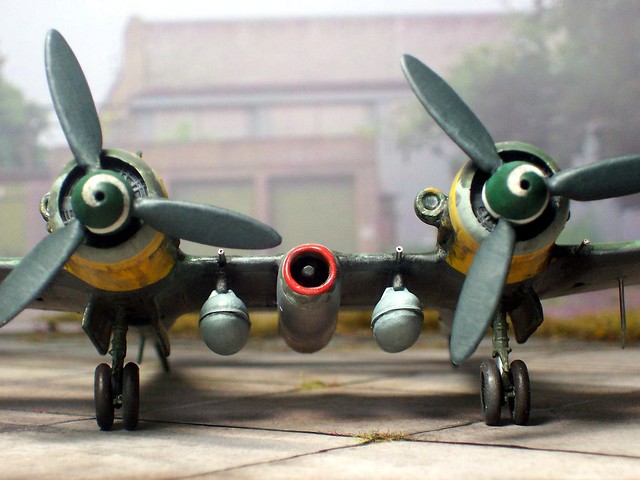
1:72 Focke Wulf Fw 190 Z-17, aircraft „<1+–“, personal mount of Leutnant Werner von Giesen; Deutsche Luftwaffe, Stab of II./JG 53's; Kaufbeuren, early 1946 by dizzyfugu, on Flickr

1:72 Focke Wulf Fw 190 Z-17, aircraft „<1+–“, personal mount of Leutnant Werner von Giesen; Deutsche Luftwaffe, Stab of II./JG 53's; Kaufbeuren, early 1946 by dizzyfugu, on Flickr
With its two Jumo 213E engines the Z-16 was capable of speeds up to 755 km/h (472 mph) at 13,500 m (41,000 ft, using the GM-1 nitrous oxide boost) and 560 km/h (350 mph) at sea level (using the MW 50 methanol-water boost). To help it attain this speed, it used the MW 50 system mainly for lower altitudes (up to about 10,000 m/32,800 ft) and the GM-1 system for higher altitudes, although both systems could be engaged at the same time.
A further step in order to increase performance was the experimental installation of a jet booster: a single Junkers Jumo 004 B-1 turbojet, rated at 8.8 kN (1,980 lbf) was installed under the central wing section, with wet hardpoints for two 250 l (55 imp gal; 66 US gal) drop tanks on each side.
The results were so promising (top speed climbed to 805 km/h/500mph while range was not reduced) that this Rüstsatz measure, originally designed only as an optional feature for a Z-16/R-1, was fully integrated into the production type, which became the Fw 190 Z-17. This type was immediately ordered into series production in September 1945 and was to fully replace the Z-16, which had just been started to be delivered to the Luftwaffe.

1:72 Focke Wulf Fw 190 Z-17, aircraft „<1+–“, personal mount of Leutnant Werner von Giesen; Deutsche Luftwaffe, Stab of II./JG 53's; Kaufbeuren, early 1946 by dizzyfugu, on Flickr

1:72 Focke Wulf Fw 190 Z-17, aircraft „<1+–“, personal mount of Leutnant Werner von Giesen; Deutsche Luftwaffe, Stab of II./JG 53's; Kaufbeuren, early 1946 by dizzyfugu, on Flickr
Anyway, as the Jumo 004 was mostly reserved for the Me 262 'Schwalbe' jet fighter and the simpler Ta 152 still had development priority, only about 50 Z-17 and a further 40 Z-16 without the jet booster were delivered until the hostilities ended. They were exclusively used in the Zerstörer (Bomber destroyers) role. From the pilots the Fw 190 Z earned the nickname “Gurkenhobel” (Cucumber slicer), due to its unique shape, but it was nevertheless well-liked and its firepower made it an effective weapon against Allied bomber formations.

1:72 Focke Wulf Fw 190 Z-17, aircraft „<1+–“, personal mount of Leutnant Werner von Giesen; Deutsche Luftwaffe, Stab of II./JG 53's; Kaufbeuren, early 1946 by dizzyfugu, on Flickr

1:72 Focke Wulf Fw 190 Z-17, aircraft „<1+–“, personal mount of Leutnant Werner von Giesen; Deutsche Luftwaffe, Stab of II./JG 53's; Kaufbeuren, early 1946 by dizzyfugu, on Flickr
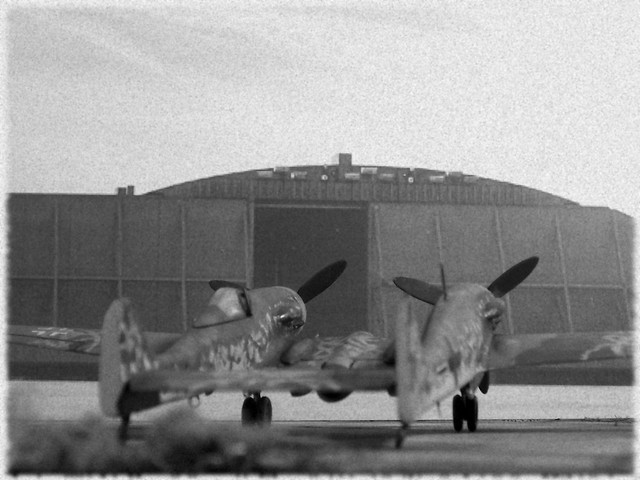
1:72 Focke Wulf Fw 190 Z-17, aircraft „<1+–“, personal mount of Leutnant Werner von Giesen; Deutsche Luftwaffe, Stab of II./JG 53's; Kaufbeuren, early 1946 by dizzyfugu, on Flickr
Plans had been made to develop the Fw 190 Z into a two-seated night fighter (with the second cockpit in the right fuselage re-installed), but this was not carried out. A high altitude version, with the long outer wings from the Ta 152 H, also remained on the drawing board, and at least one Z-16 had been tested with a 55 mm MK214 autocannon, carried in a streamlined pod under the central wing where the Z-17’s jet booster was originally installed.
General Focke Wulf Fw 190 Z-17 characteristics:Crew: 1
Length: 10.20 m (33 ft 5½ in)
Wingspan: 14.580 m (47 ft 9 in)
Height: 3.35 m (11 ft 0 in)
Empty weight: 15,997 lb (7,271 kg)
Loaded weight: 4,270 kg (9,413 lb)
Max. takeoff weight: 11,632 kg (25,591 lb)
Powerplant:2× Junkers Jumo 213E liquid-cooled inverted V-12, 1,287 kW (1,750 PS; 2,050 PS with MW-50 boost)
1× Junkers Jumo 004 B-1 turbojet, rated at 8.8 kN (1,980 lbf)
Performance:Maximum speed: 805 km/h (500 mph) at 6,600 m (21,655 ft), 740 km/h (460 mph) at 37,000 ft (11,000 m)
Range: 1.800 mi (1.563 nmi, 2.900 km)
Service ceiling: 12,000 m (39,370 ft)
Rate of climb: 17 m/s (3,300 ft/min)
Armament:2× 30 mm (1.18 in) MK 108 machine cannon with 110 RPG, firing through the propeller hubs
4× 20 mm MG 151 cannons with 250 rpg in the wing roots
Up to 1.000 kg (2.202 lb) of external ordnance at two hardpoints under the central wing, including bombs, drop tanks; under the outer wings additional hardpoints for four 50 kg (110lb) bombs, two racks with 12 unguided 'R4M' 55 mm (2.2 in) each, two pods with 2× 20mm MG 151/20 machine guns each or up to four WGr21 launch tubes

1:72 Focke Wulf Fw 190 Z-17, aircraft „<1+–“, personal mount of Leutnant Werner von Giesen; Deutsche Luftwaffe, Stab of II./JG 53's; Kaufbeuren, early 1946 by
dizzyfugu, on Flickr

1:72 Focke Wulf Fw 190 Z-17, aircraft „<1+–“, personal mount of Leutnant Werner von Giesen; Deutsche Luftwaffe, Stab of II./JG 53's; Kaufbeuren, early 1946 by
dizzyfugu, on Flickr
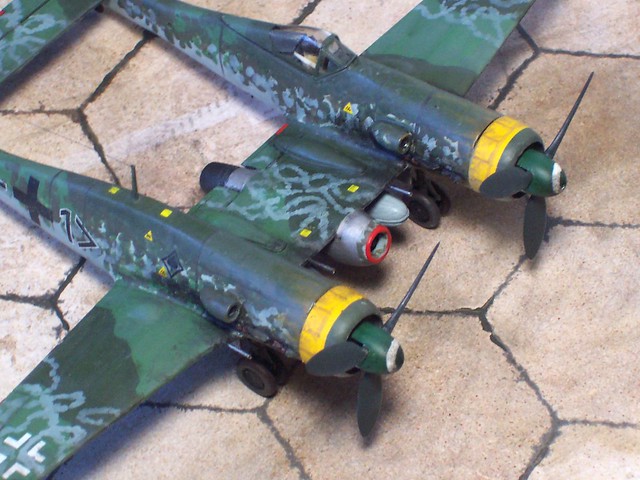
1:72 Focke Wulf Fw 190 Z-17, aircraft „<1+–“, personal mount of Leutnant Werner von Giesen; Deutsche Luftwaffe, Stab of II./JG 53's; Kaufbeuren, early 1946 by
dizzyfugu, on Flickr

1:72 Focke Wulf Fw 190 Z-17, aircraft „<1+–“, personal mount of Leutnant Werner von Giesen; Deutsche Luftwaffe, Stab of II./JG 53's; Kaufbeuren, early 1946 by
dizzyfugu, on Flickr
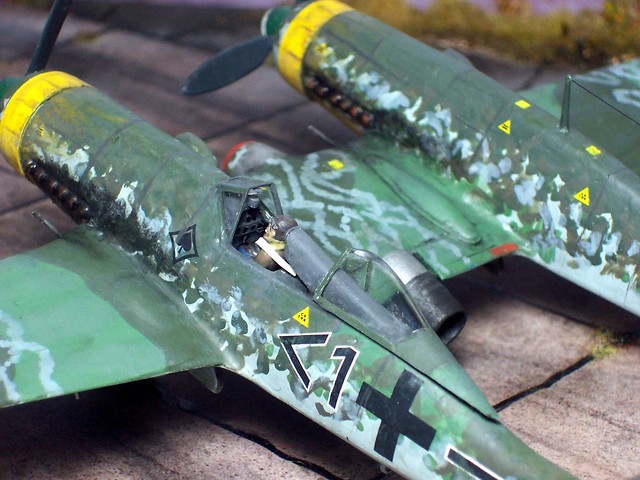
1:72 Focke Wulf Fw 190 Z-17, aircraft „<1+–“, personal mount of Leutnant Werner von Giesen; Deutsche Luftwaffe, Stab of II./JG 53's; Kaufbeuren, early 1946 by
dizzyfugu, on Flickr

1:72 Focke Wulf Fw 190 Z-17, aircraft „<1+–“, personal mount of Leutnant Werner von Giesen; Deutsche Luftwaffe, Stab of II./JG 53's; Kaufbeuren, early 1946 by
dizzyfugu, on Flickr